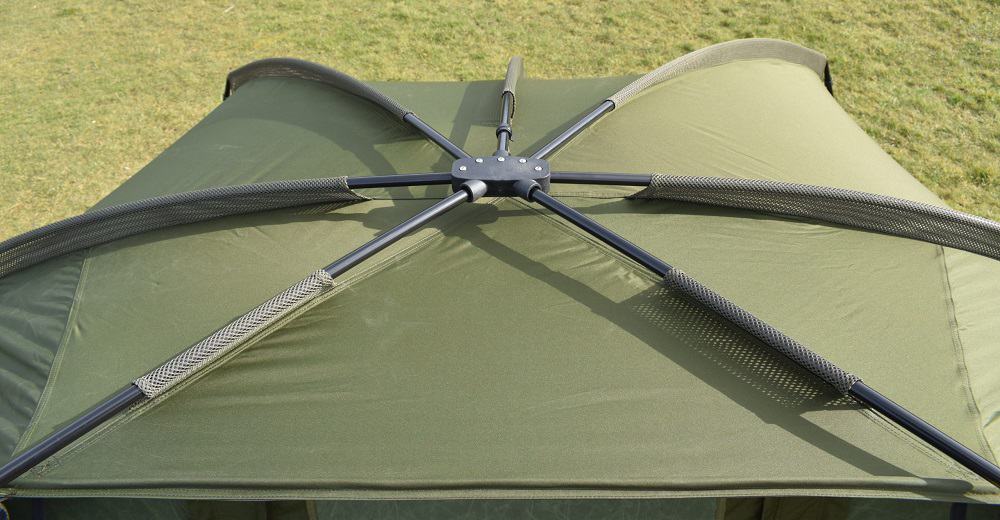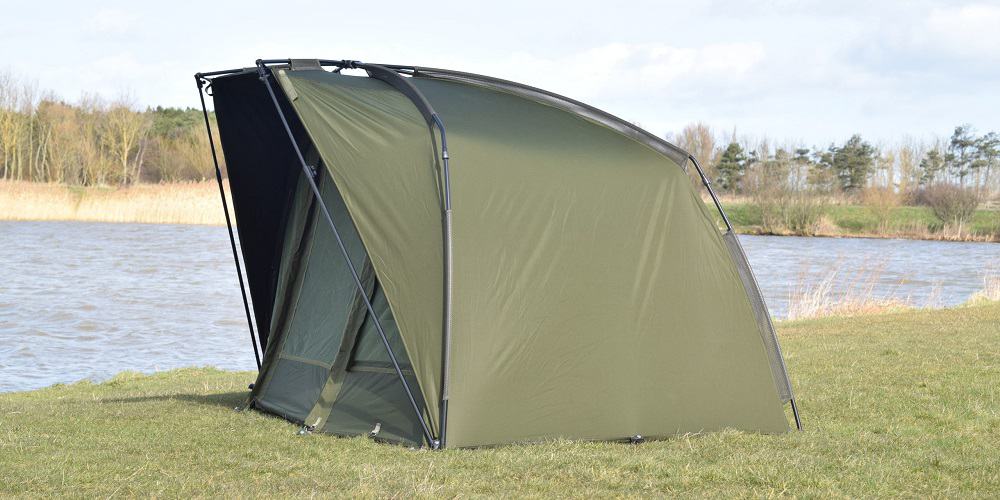I decided to treat myself to a new shelter, and of all the bivvies in the price range I was considering, it was the Sonik AXS Bivvy that stood out to me.
My choice criteria were:
- Marketed by a well-known brand
- Must include a peaked front
- Wouldn’t break the bank
- Had an overwrap option
While there was a number of bivvies that ticked all of the boxes above, I found that they either had mixed reviews online or were out of stock.
As I own a couple of other Sonik products, I knew that their customer service was good, so I decided to throw caution to the wind and splash the cash on their AXS Bivvy.
Sonik AXS Bivvy
Quick Look
The AXS Bivvy from Sonik is one of the best options available in the mid-range bivvy market. Is it as good as a £700+ bivvy? Probably not. Is it one of the best bivvies that you can get for under £300? Absolutely.
Overall
-
Design
-
Material
-
Internal Space
-
Features
-
Setup
-
Groundsheet
-
Storm Poles
-
Carry Bag
Pros
Quick to set up/pack away Small footprint Packed with features
Cons
Quite small inside Groundsheet clips are flimsy Carry bag is poor quality
Design
The design of the Sonik AXS Bivvy was what made me take notice of it as soon as I laid eyes on it. The central hub allows for a rapid setup and the high-back style maximises the space within what is a very compact footprint.
The Sonik AXS Bivvy can easily be converted into the Sonik AXS Shelter by simply removing the front panel, which effortlessly zips on and off within a matter of seconds. It was this versatility that was one of the main reasons why I decided to purchase this bivvy.

Material
When I bought my previous bivvies, I tended to select one based on how good it looked in comparison to the price tag and never really paid attention to the material or what the ratings meant.
The material that bivvies are manufactured from is rated by HH (or “Hydrostatic Head”), and this rating is measured in millimetres. If a bivvy has a 1,000mm HH rating, it means that a 1,000 millimetre column of water could stand on the fabric before it would penetrate it.
The Sonik AXS Bivvy is manufactured from their own Cloudbase fabric, which boasts a 10,000mm HH rating (This means that it would take a water column in excess of 30ft high to penetrate the fabric).
My previous bivvy only had a 5,000mm HH rating, so I was immediately able to notice the difference in thickness when I set this bivvy up for the first time. Whereas the daylight easily penetrated through the fabric of my old bivvy, when I am fully zipped up in my Sonik AXS Bivvy, it remains very dark inside.
Internal Space
The internal space of the Sonik AXS Bivvy is advertised as:
- Width = 2.6m
- Depth = 1.75m
- Height = 1.37m
The width is ample and the high-back design means that the height is consistent throughout the entire bivvy, rather than being slanted like it is on a lot of shelters from other manufacturers.
At only 1.75m, the depth is rather shallow and I would certainly class this as a compact 1 man bivvy. I have a standard width bedchair, and by the time that is in place at the back of the bivvy and my luggage is in either corner, it doesn’t really leave a lot of room elsewhere.
Having said that, as long as you maximise the room by storing unused items under your bedchair where possible, it is still comfortable enough for short or mid-length sessions and the peaked front extends far enough to allow your feet to be outside the door without getting wet in the rain.
Features
The Sonik AXS Bivvy ships with everything included in the box. (The only optional purchase that may be required would be the overwrap).
To the rear of the bivvy are two mozzie/air vents that are secured in place with velcro. These can be rolled up completely to allow air flow through the bivvy on those hot summer sessions and are also supplied with small spacers that enable use even during a downpour. Attached to these air vents are two large mesh pockets where you can keep your wallet, keys and other valuables.
There are three different door options, with clear and mozzie options supplied in addition to the standard green material. The door has 2-way zips, meaning that you can use it letterbox style or fully zipped in more severe conditions. Either side of the door are more mesh pockets which I find are ideal for storing a power bank, mobile phone or some tackle essentials.

Setup
In previous years, some of my bivvies have taken upwards of 10 minutes to make them habitable, so this time around, I was looking for something that went up super-quick (In my opinion, there is nothing worse than arriving at the lake while it is hammering down with rain and being soaked through before you have managed to get your rods out).
The Sonik AXS Bivvy goes up very rapidly and I have managed to get it out of the bag, connect the anti-twist poles, peg it into position and adjust the tension straps in under 90 seconds!
Once that is completed, all you then need to do is zip on the front panel and clip the groundsheet into position, giving a total setup time of less than 3 minutes.
Trending: Do you use distance sticks for accurate casting? Here are some of the best on the market
Groundsheet
The groundsheet that ships with the Sonik AXS Bivvy is described as heavy duty. While it is definitely thicker and more durable than a lot of bivvy groundsheets I have come across, I don’t know if I would describe it as heavy duty (I think the true test of this will be in the winter when I will expect the groundsheet to act as the first layer of insulation).
The groundsheet has 5 clips that enables it to be secured in place over the skirt edge of the bivvy. The clips are made of the same plastic that is used for the clips that fix the door in place when rolled up. While these are by no means poor quality, I imagine that they could get damaged quite easily if a bedchair leg was to be placed on them or if they were repeatedly stepped on.

Storm Poles
The Sonik AXS Bivvy is supplied with two 48″ storm poles which boast a quick-connect attachment. While they will be really helpful when using the bivvy with the overwrap, they really increase the rigidity of the bivvy when using it as a single-skin and make it even more solid than it is as standard.
Carry Bag
The bivvy, groundsheet, front panel, storm poles and pegs all zip into an oversized compression bag.
While the bag should stand the test of time if treated well, it isn’t constructed from the strongest material and I feel that it could easily rip, potentially damaging the bivvy if it is inside at the time.
Personally, I would have preferred to pay a little extra and be able to transport my bivvy in something that is a little more hardwearing, rather than being concerned if my bivvy will make it to the peg in one piece.
Conclusion
The Sonik AXS Bivvy is an excellent shelter at a fantastic price.
This bivvy boasts the design, material, setup time and features of one that typically carries a much higher price tag. If there was slightly more room inside and the carry bag was of better quality, then this bivvy would be almost unbeatable.
Do you own the Sonik AXS Bivvy? If so, what are your thoughts about it? Please let me know in the comments

